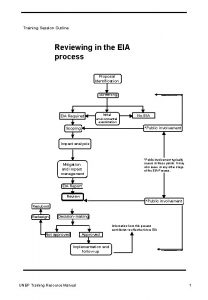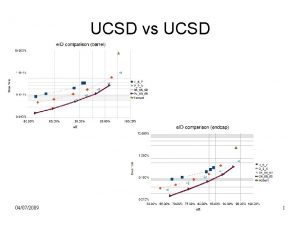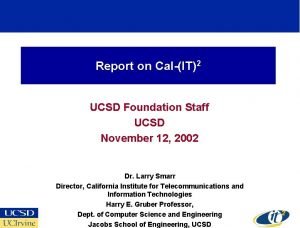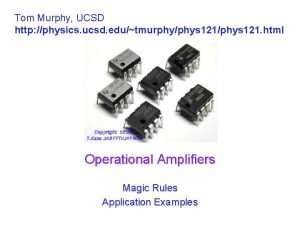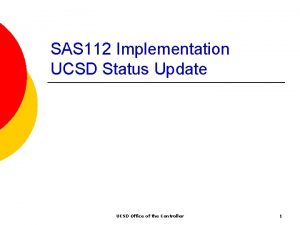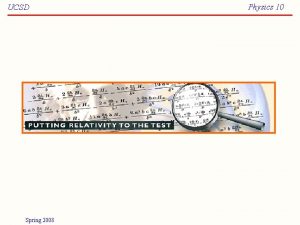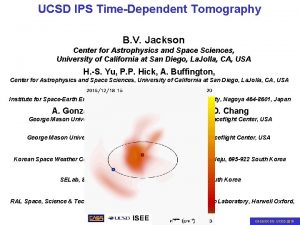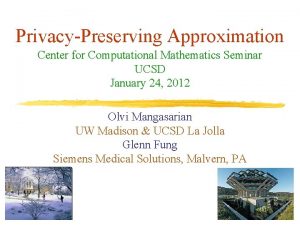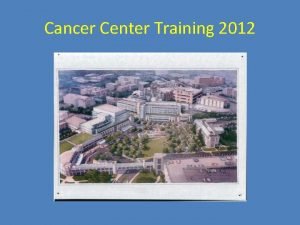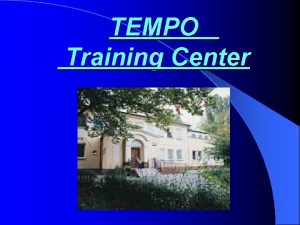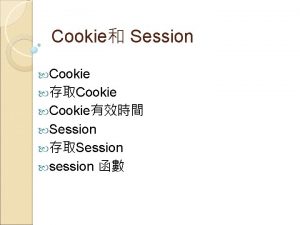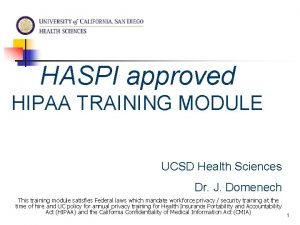3 T GE Training Session UCSD Center for



























- Slides: 27

3 T GE Training Session UCSD Center for Functional Magnetic Resonance Imaging March 2004

Introduction n Safety Magnetic Room Equipment Console Room Overview • • • n n n Desktop Keyboard Scan Rx Desktop Selecting a Protocol Graphical Prescription f. MRI Study Data Management Reset the TPS

Safety n Eliminate Magnet Hazards • Keep metal out of the magnet room n Subject Preparation • • n Screening Provide information Test intercom Enter the correct subject weight Turn on the bore light and fan Show the subject how to turn on the patient alert system Provide ear protection for the subject Instruct subject to close his or her eyes when the alignment light is on. Bore Temperature

EXCITE Platform n n EXCITE: Ultra-fast, scalable, data acquisition and reconstruction hardware. Scalable from low end to ultra-high end (r. BW and channels). Rapid, parallel processing Reconstruction: 100 -400 frames/sec. • Architectural support for up to 1600 frames/sec. n Hardware: • • HP x 8000 Workstation Dual 2. 66 GHz/533 MHz Bus Intel Xeon CPU’s 108 GB Disk Host Operating System: Red Hat Linux 7. 3

Magnetic Room Equipment n n 3 T magnet labels: fmri 3 tw (host computer), fmri 3 tww (Advantage workstation). The 3 T magnet is equipped with: • Physiological Acquisition Controller (PAC) n n n • • • Respiratory compensation bellows A six pin connection for a high impedance ECG leads Peripheral gating: a fiber optic connection for the peripheral gating lead Patient call to signal assistance Pulse meter MRI Devices 8 channel high resolution brain coil (HRBRAIN) 1 channel birdcage volume head coil Two actively shielded gradient coils: n n Zoom: Optimizes slew rate and amplitude for small FOV applications. Max. FOV: 35 cm (S/I), 44 cm (A/P), 44 cm (R/L) Whole Body: Intended for large FOV applications

Status Display Panel: located on the magnet cover Pressing Emergency Stop on the operators console: • The scan aborts • The power disables the patient handling and scan related equipment

Control Panel Button Alignment light on the magnet control panel button Control Panel Button in the magnet room Move to Scan: the table moves to patient isocenter

Desktop Overview 1. 2. 3. 4. 5. 6. 7. 8. 9. 10. 11. 12. 13. 14. Desktop control panel System status display Area title Text box Pull down menu Autoview window Image slider System activity status Window toggle button Pop-up window button List/Select menu Scroll arrows Control panels Scan operation area

Patient Information/Position Panel Abbreviated Patient Information Full Info n n n n Accession Number: Typically prescribed by hospital Patient ID: Any combination of numbers, letters and dashes. Limited to 64 characters. System will notify if identical ID is found. Patient Name: Limited to 64 characters and should not be preceded by numbers. Rad: Name of radiologist – can be used to specify PI. Refer: Name of referring physician – also available for PI specification. Operator: Any combination of 3 characters. Patient Position: Typical setting: Supine, Head First, HRBRAIN

Keyboard 1. 2. 3. 4. 5. 6. 7. 8. 9. 10. 11. 12. 13. Emergency stop Operator microphone Patient speaker Microphone volume adjust Press to talk Start Scan Pause Scan Stop Scan Move to Scan Stop Move Scan Host Computer Control Functional Keys Keyboard

Selecting a Protocol Site: Standard Protocols placed by the Center. Including: • BIRN • f. MRI • f. RMI-All Other: Protocols belonging to each group is placed Protocols selected from any of the protocol libraries (Site, GE) can be modified and saved in the Site (other) Library. Also available is the Protocol Lockout that restricts site protocols by requiring password.

The Rx Manager n n The Rx manager is used to create, view, edit, and prepare series for scanning. The Rx manager list shows the prescribed series state and series description: • New: series is not prescribed or saved and cannot be scanned • INRX: (in prescription) series is opened, not yet saved, and cannot be scanned. • RXD: (prescribed) series is saved and can be scanned • ACT: (active) series is ready for scan and can no longer be edited • SCND: (scanned) series has been scanned and can no longer be edited but can be re-scanned. • PSCD: (pre-scanned) series is prescanned and ready for scan.

Graphical Prescription 2 D graphic object 3 plane graphic prescription 3 D graphic object

f. MRI Study n n n 3 -Plane localizer Functional scan (s) High resolution structural scan Added scans could include n High-order Shim n 3 D Arterial TOF n Phase map n 2 D Venous TOF

Prescanning n n Automatic Prescan: Automatically adjusts the center frequency and the transmit and receiver gain. Manual Prescan: Allows manual adjustment of prescan parameters. Select Auto. Prescan or Manual Prescan • Caution: You are delivering RF to the patient during prescan. Manual Prescan window

Shimming n n n Autoshim: Improves image quality by optimizing the X, Y, Z gradient settings. It is the system’s default and is included in the prescan. High Order Shims: Allow shimming over a ROI, and likely to improve local field inhomogeneity. If you enable the [Autoshim] option after running a High Order Shim seris, you will receive a message informing you that scanning with this series resets ALL the shim coils, i. e. all shim channels will be reset to zero. ROI Selection Window 1. Select a ROI to run shim value 2. Calculations with current ROI 4. If difference is significant, press Done, otherwise Quit. 3. Compare calculated and predicted RMS Caution: After High Order Phase Correction, make sure the Phase Correction Option is ON, and only the Auto. Shim option is turned OFF.

3 -Plane Localizer n n The 3 -Plane localizer acquires three planes in a single acquisition, eliminating the need for three separate scans. It then displays the 3 -planes in graphic Rx to prescribe off of.

f. MRI Imaging Options n n n Imaging Options: A list of imaging options from the Imaging Parameter area. Availability depends on pulse sequence and system configuration. GRE EPI Imaging Options Include: • ASSET, Cardiac Gating/Triggering, f. MRI, IR prepared, sequential, multiphase, etc.

f. MRI with Brain. Wave RT n Brain. Wave Real-Time software features: • Overlay of segmented image with functional image set. 1. 2. 3. 4. Acquire a high resolution structural scan Acquire f. MRI data with Brain. Wave RT Perform segmentation Visualize f. MRI data with Brain. Wave PA

User Control Variable Acquisition of echoes during the rise and fall times of the gradient slope. Use Spin Echo EPI to generate phase correction coefficients. Default setting: Ramp Sampling = 1, Spin-Echo Reference Scan = 0 To change the receiver bandwidth (r. BW), set at 250 k. HZ, the ramp sampling first be must be turned off. This will allow the user to make changes to r. BW.

f. MRI Control Window • The f. MRI Control Window is the default window that launches after [Prep Scan] button is clicked. • It is used to prepare, start, stop the f. MRI acquisition. • Takes an image capture of all or one the images in the RT. Starts the f. MRI acquisition Statistical Threshold Slider Allows selection of matched structural scan Caution: You must Close the f. MRI Control window before proceeding. Failure to do so will prevent you from scanning the next Rx.

Paradigm Manager. Specify a paradigm name 0 means initial state is rest, 1 means initial stat is stimulus rest reps and stimulus reps per cycle Total reps Can add and delete an entry but cannot modify an existing paradigm.

Paradigm Development Select Paradigm Interleaved/Sequential Internal/External n n Clicking the f. MRI Screen icon opens the f. MRI additional parameter window which has available a number of standard f. MRI paradigms (including the ones you have previously created) and sequence parameters. Research mode: When the research agreements have been signed, this step will no longer be required. One can generate f. MRI paradigms during the series prescription.

Image Management Feature Status Area (located below the Desktop Control Panel): Scan reconstruction status Filming status Network status Archive status Managing Disk Space: % disk is full Center Recommendations: It is recommended for the disk occupancy not to exceed 50%. We hope that each group removes their data within a one week period of the scanning session. If you have started an exam and notice that the disk occupancy is high, you may remove data starting from the least recent, and not to exceed a one week window. Caution: There is no protection for data belonging to other group.

Networking-Image Transfer’s data by exam. Transfer’s data by series. Data can be transferred to a number of locations such as the Advantage Window. See the instructions for data transfer to the fmriserver for transfering data to the server.

TPS Reset / System Shutdown n n The TPS is a subsystem that overseas all raw data processing. Resetting the TPS is one way to safely recover from many errors and conditions. Is performed 2 -3 times/week Might be necessary during a scan • Caution: Performing a TPS reset in the middle of a scan or reconstruction stops the reconstruction, eliminates the landmark, and deletes the image data. n n n Click on the Service Desktop icon Click [TPS Reset] Wait for a TPS reset is completed message. Re-landmark and resume scanning System Shutdown: terminates power to the system electronics in an orderly fashion so that image files are saved, but does not turn off power to the MRI magnet.

Additional Notes n n A data transfer and conversion to AFNI program has been constructed by Eman Ghobrial. In addition to the general training, we plan to have additional training designed to the individual needs of each group so please let us know if you have particular needs.
 Ucsd summer session
Ucsd summer session Training session outline
Training session outline Facilitating learning session
Facilitating learning session Training session design
Training session design Welcome to the training session
Welcome to the training session Talk boost tracker
Talk boost tracker Opening prayer for training session
Opening prayer for training session Kontinuitetshantering i praktiken
Kontinuitetshantering i praktiken Novell typiska drag
Novell typiska drag Nationell inriktning för artificiell intelligens
Nationell inriktning för artificiell intelligens Ekologiskt fotavtryck
Ekologiskt fotavtryck Varför kallas perioden 1918-1939 för mellankrigstiden?
Varför kallas perioden 1918-1939 för mellankrigstiden? En lathund för arbete med kontinuitetshantering
En lathund för arbete med kontinuitetshantering Personalliggare bygg undantag
Personalliggare bygg undantag Personlig tidbok
Personlig tidbok A gastrica
A gastrica Förklara densitet för barn
Förklara densitet för barn Datorkunskap för nybörjare
Datorkunskap för nybörjare Stig kerman
Stig kerman Debatt artikel mall
Debatt artikel mall Magnetsjukhus
Magnetsjukhus Nyckelkompetenser för livslångt lärande
Nyckelkompetenser för livslångt lärande Påbyggnader för flakfordon
Påbyggnader för flakfordon Tryck formel
Tryck formel Publik sektor
Publik sektor Jag har gått inunder stjärnor text
Jag har gått inunder stjärnor text Presentera för publik crossboss
Presentera för publik crossboss Jiddisch
Jiddisch

